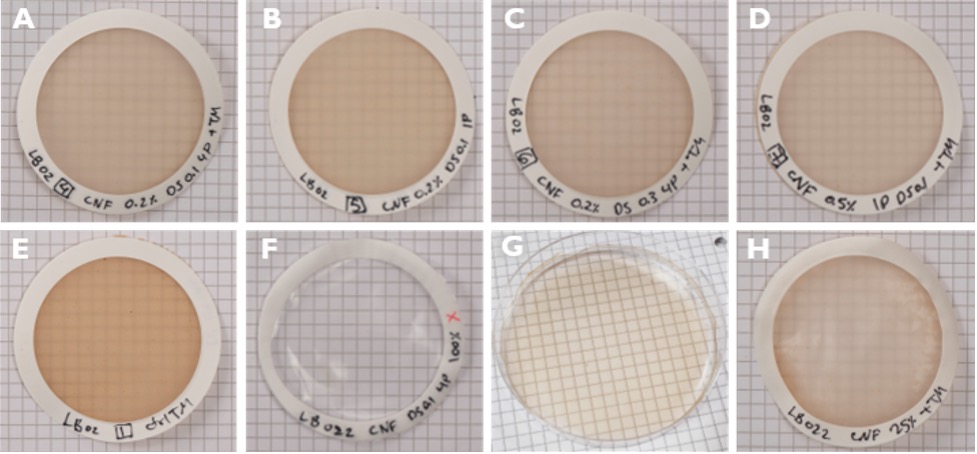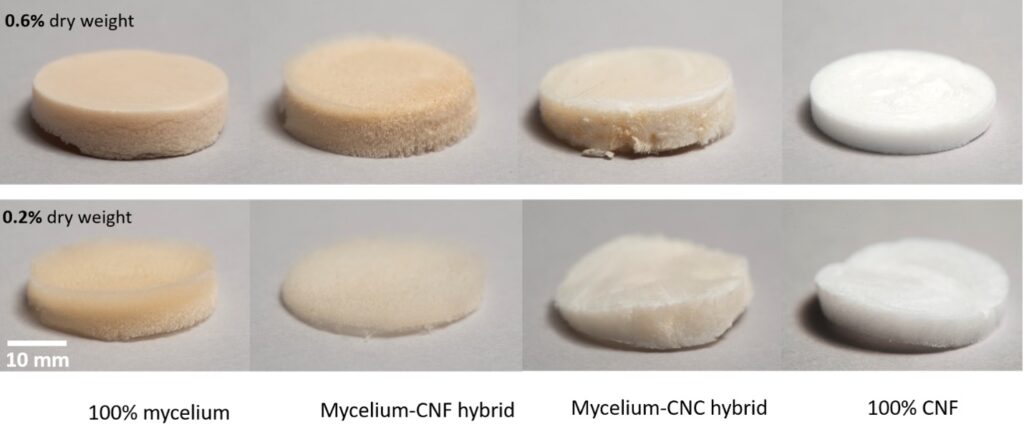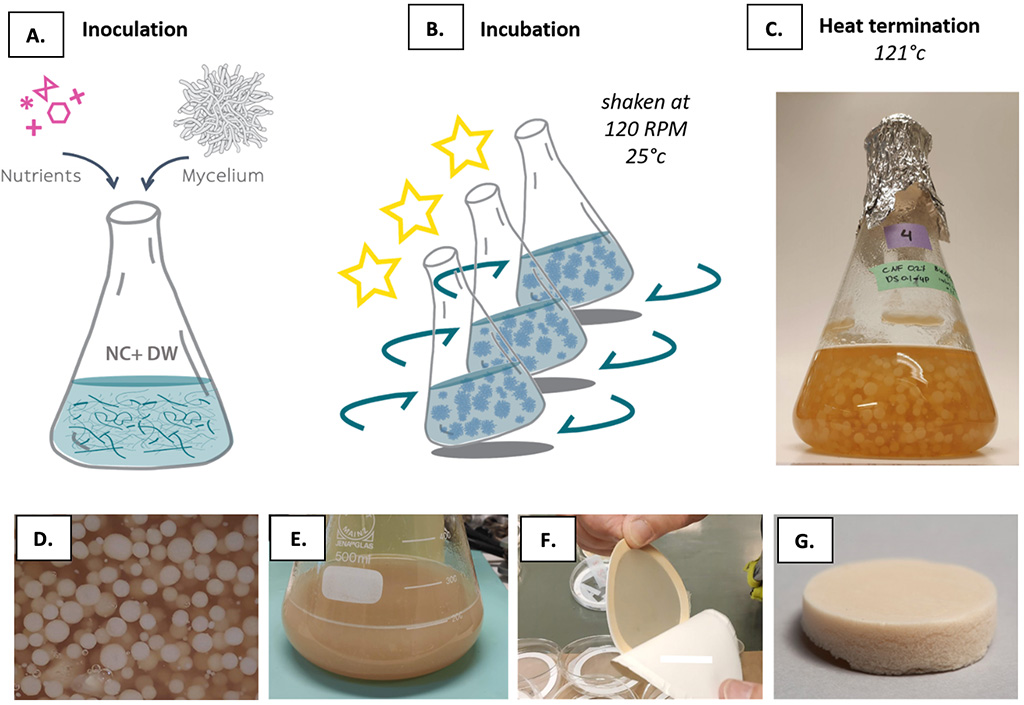
Mycelium in architecture and industrial design: utilizing bio mechanisms to develop mycelium composites
The general aim of this research is to explore and develop mycelium-cellulose hybrids as a new type of humidity resistance packaging and hygiene product material that is sustainable, scalable, inexpensive, and uses existing pulp and paper industrial infrastructure to process and shape the hybrid material into functional products that offer clear gains compared to traditional paper or plastic-based packaging solutions.
The research focuses on the development of novel sustainable bio-nano hybrid composite materials produced from an integration of, fungal mycelium and nanocellulose (NC) (Figure 1, 2). In this integrated material system, the NC acts as a reinforcing substrate for the mycelium, cueing changes in the morphology and properties of the resultant hybrid bio-composites. This work required the use of multidisciplinary tools and knowledge, with scientific efforts to understand the biological and biochemical interactions within the nano to macro scale of the material.
A provisional patent application that was filed in September 2020, through the Technion (TRDF 2020055). The patent opened the way for commercialization of the material in two large markets: Hygiene products – as a sustainable recyclable material for dippers and other hygiene products. Packaging products – as a sustainable recyclable material for packing that employs mycelium antibacterial properties and extends products’ life.

Figure 1: Hybrid mycelium-Nanocellulose films in varied compositions. [A] Hybrid with 40% CNF DS 0.1 4p; [B] Hybrid with 40% CNF DS 0.1 1p; [C]Hybrid with 35% CNF DS 0.3 4p[D] Hybrid with 60% CNF DS 0.1 1p; [E] 100% T. Ochracea; [F] 100% CNF DS01 4P [G] Hybrid with CNC [H]Mixture (post incubation) 25%CNF, 75%mycelium; All co-incubation hybrid films result in fine and uniform materials(A-G); Post-incubation mixture is more distorted and clearly not homogenic (H).

Figure 2: Hybrid mycelium-Nanocellulose films in varied conpositions- from left to right: 100% T.ocrachea; Hybrid with ~50% CNF D.S 0.1 1P; Hybrid with ~50% CNC; pure CNF DS01 1p. Top row samples were made with 0.6% dry weight, Bottom row with 0.2% dry weight.
BACKGROUND
Alongside the need of perceptual change in global production and consumption systems emerging interdisciplinary research practices stimulate the development of sustainable materials by employing organisms as biological fabrication systems. These integrations extend the responsibilities of both scientists and designers and require cross-disciplinary collaborations, respectively. In the current study, a multidisciplinary exploration process enabled us to integrate advanced bio-fabrication technologies within a sustainable industrial design research practices, and vice versa. This methodological approach enabled fundamental understanding of the material to envision, adapt, and illustrate unique properties, implications, and production scenarios, focusing on usability and environmental aspects of the product.
Few years ago much of the knowledge in this scope was restricted by commercial companies (see for example Ecovative), yet during the last few years the commercial and academic interest constantly grows, with an increasing number of academic groups from diverse disciplines that explore and develop mycelium-based composites, expanding the knowledge regarding its fabrication possibilities, existing and potential properties, to promote alternative industrial products with circular production scenarios.
In nature, white-rot fungi mycelium develops on dead wood, dispersing within and around it, preferentially decomposing lignin while leaving much of the cellulose intact (Figure 3). The fungal cell wall is composed of a dynamic and heterogeneous interwoven mesh of chitin, glucans, glycoproteins, and other polysaccharides, creating interconnected networks, which together provide the properties required to withstand high internal hydraulic pressures, provide physical protection, and maintain internal humidity that is essential for fungal development. These properties play an important role when mycelium is employed as a structural material.

Figure 3: The fungal mycelium. From left to right: Illustration of fungal mycelium, comprising the fruiting body of the fungi (a mushroom) and the vegetative network below the surface (from Life, The Science of Biology, 10th ED); Mycelium on pine woodchips found in nature; A 3mm mycelium inoculum disk dispersing on woodchips in the lab, under sterile conditions; HR-SEM image depicting mycelium within a wheat straw plant cell.
So far, most of the intellectual property and academic study in the emerging field of mycelium-based composites was mainly focused on incubation of mycelium with plant-chips, sourced from regional agricultural and forest pruning residues that currently do not have practical discarding solutions. The initial part of our research explored the potential uses of mycelium-woodchip biocomposites for sustainable industrial design applications, using regional forest and agricultural wastes. One fundamental finding was that the mycelium is generally hydrophobic on its external areas; thus, it decreases the hydrophilic nature of the woodchips, commonly resulting in amphipathic water-interface properties. This finding established the scope for the second part of this study, that focused on exploring the potential of a bio-nanocomposite hybrid material made of mycelium and nanocellulose, presuming that an integration of these materials would produce resilient films with improved the water resistance.
The invention presents and includes composite materials that comprise mycelium in combination with plant-derived substances such as cellulose and/or cellulose-based materials. Our study explored the potential integration of the two forest-based materials, fungal mycelium and nanocellulose (NC) using submerged culture growing method. This is a commonly used method for industrial production of fungi, in which mycelium may be grown in enriched liquid broth with desired conditions, forming macroscopic hyphal aggregates, which are then processed to extract different microbial products. In the current approach, the mycelium incubation is accompanied by the addition of NC to the liquid broth. These bio-based materials are exceptionally promising for sustainable industrial applications as they can be readily processed into applicable materials with versatile range of properties using similar infrastructure, tools, and methods of paper processing to produce materials such as films or sheets for packaging with valuable mechanical performance and barrier properties to oxygen, grease, UV, and humidity.
We found that white-rot mycelium grown in a liquid culture that includes growth nutrients and nanocellulose (CNC, CNF) incorporates the nanocellulose within its filamentous structure to give a mycelium-nanocellulose biocomposite hybrid. Generally, the strength of the mycelium is improved by the inclusion of nanocellulose and the surface properties of the resulting film are dominated by the mycelium, which is more hydrophobic and essentially coats and integrates within it the nanocellulose elements. This 1-step bio-fabrication of a mycelium-nanocellulose nanohybrid material gives materials that can be processed in the ways familiar to papermaking, are water-resistant, thermally stable, mechanically robust, and potentially anti-bacterial and anti-fungal. Of all the NC types tested (enzymatic CNF, carboxymethylated CNF, CNC), carboxymethylated CNF gives an increase in the yield of mycelial mass, all else kept equal. Lastly, simply adding nanocellulose to mycelium does not produce a uniform material, so the inclusion of nanocellulose in the growth medium is a key element.
Several analysis methods (XPS, POM, HR-SEM, FTIR, AFM, contact angle), supports the conclusion that in the invented material, NC (nm-scale and otherwise) is fully absorbed, interlaced, and engulfed by mycelium, and potentially integrated within the hyphal cells, respectively affecting physio mechanical material properties. This observation is perhaps most visually evidenced by POM, where the non-birefringent rippled hyphal network appears superimposed over the NC (see Attias et al. 2020). This observation was consistent across all NC types employed in this study, although their sizes, nano-yield, morphologies, and charges differed significantly. Furthermore, evidence was provided to support the assembly and integration of the NC nano-fraction within the hyphal cell walls and not simply aggregated onto the cell wall exterior as evident in studies that use mycelium to take in ions from the liquid media to form nanoparticles. In fact, we did not find any study that demonstrates an incorporation of nanoparticles into the fungal pellet/ cell wall.
Mycelium liquid culture is already quite straightforward and scalable fabrication process, however the main innovation is the addition of nanocellulose to the growth medium, by replacing the distilled water ingredient with NC in varied wt%, to produce an integrated NC-mycelium biocomposites with hybrid properties. Mycelium-nanocellulose bio-composites can be processed in the ways familiar to nanocellulose or mycelium-based composites, such as vacuum filtration, standard molding, 3D pulp molding, 3D printing, spraying, freeze dry etc. The results of our study suggest that a family of differentNC-mycelium bio-composites can be readily achieved by varying NC content and type, incubation time, nutrient profile, fungal species, growth conditions and material processing methods, with a potential to tailor diverse materials depending on the desired application of interest. Notably, we found that carboxymethylated CNF gives a higher yield of the mycelial mass and that the dewatering stage of a mycelium-NC hybrid is faster compared to pure NC processing.

Figure 4: The selected fabrication approach. (A) Inoculation of mycelium pieces with nutrients and nanocellulose in sterile conditions; (B) Incubation at 25°c, agitated at 120RPM speed; (C-D) Following incubation, the material develops as a spherical pellet surrounded by a broth. The growth process is terminated by heat treatment. (E) The mixture is homogenized, dialyzed or centrifuged to remove residual nutrients. (F) The diluted mixture is used to make films - by vacuum filtration and drying under tension using customized cleaves. (G) Aerogels are made using freeze-drying of a diluted homogenized liquid mixture.
The studies show that different fungal species, substrates, and approaches have been used to produce biocomposites with distinct properties. Space-filling composites produced from the solid-state cultivation of Trametes versicolor, Trametes ochracea, or G. sessile with various substrates from agricultural waste presented different characteristics depending on the fungus-substrate combination [Attias et al., J Clean Prod 2019, 119037]. Films from G. lucidum or Pleurotus ostreatus were stiffer when grown from a feeding substrate composed of microcrystalline cellulose (MCC) than of a mixture of MCC and easier to digest potato dextrose broth.
Funding:
Bio composite materials in design: developing 3D printing methods for fungal mycelium-based materials. Principal investigator. Israel Science Foundation (ISF). 2019
Superabsorbent bio nanocomposites from mycelium and nanocellulose. Collaborative partner/resource staff. PI. In collaboration with; Dr. Tiffany Abitbol (PI); Dr. Jens Sommertune (resource staff); Dr. Anna Carlmark (resource staff) - RISE Research Institutes of Sweden; Bo Rydin Foundation, Sweden. 2018
Scientific papers that were published on this research:
Attias, N. Danai, O. Tarazi, E. Grobman, Y. J. “Developing novel applications of mycelium-based bio-composite materials for architecture and design”. Building with bio-based materials: best practice and performance specification. September 6th-7th. Zagreb, Croatia. 2017
Attias, N. Danai, O., Tarazi, E. Pereman, I. Grobman, Y. J. Implementing bio-design tools to develop mycelium-based products. The Design Journal. 22(1) 1647-1657. 2019. DOI: 10.1080/14606925.2019.1594997.
Attias, N. Danai, O. Tarazi, E. Ezov, Pereman, I. Grobman, Y. J. Mycelium Bio-Composites in Industrial Design and Architecture: comparative review and analysis. Journal of Cleaner Production. Vol. 246. February 10th. 2020. DOI: 10.1016/j.jclepro.2019.119037. Received the Technion Jacobs Award for the Best Paper of 2020.
Attias, N. Reid, M. Mijowska, S.C. Dobryden, I. Isaksson, M. Pokroy, B. Grobman, Y.J. and Abitbol, T. Bio-fabrication of nanocellulose-mycelium hybrid materials. Advanced Sustainable Systems. November 25th. 2020. 2020. DOI:10.1002/adsu.202000196 (Paper selected for journal’s cover).
Patents:
Attias, N. Abitbol, T. Grobman, Y.J. Bio-fabrication of nanocellulose-mycelium. Provisional Patent, Application Number: 63076490 Filed on 9/2020. US Utility Patent Application No. 17/471,311 Filed on September 10, 2021.



